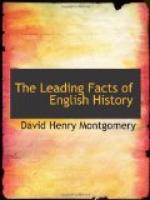The castles consisted of a square keep, or citadel, with walls of immense thickness, having a few slitlike windows in the lower story and somewhat larger ones above. In these buildings everything was made subordinate to strength and security. They were surrounded by a high stone wall and deep ditch, generally filled with water. The entrance to them was over a drawbridge through an archway protected by an iron grating, or portcullis, which could be raised and lowered at pleasure. The Tower of London, Rochester Castle, Norwich Castle, Castle Rising, Richmond Castle, Carisbrooke Keep, New Castle on the Tyne, and Tintagel Hold were built by William or his Norman successors.
The so-called Jews’ houses at Lincoln and St. Edmundsbury are rare and excellent examples of Norman domestic architecture. Although in many cases the Norman castles are in ruins, yet these ruins bid fair to stand as long as the Pyramids. They were mostly the work of churchmen, who were the best architects of the day, and knew how to plan a fortress as well as to build a minster.
V. General Industry and Commerce
157. Trade.
No very marked change took place in respect to agriculture or trade during the Norman period. Jews are mentioned in a few cases in Saxon records, but they apparently did not enter England in any number until after William the Conqueror’s accession. They soon got control of much of the trade, and were the only capitalists of the time.
They were protected by the Kings in money lending at exorbitant rates of interest. In turn, the Kings extorted immense sums from them.
The guilds (S106), or associations for mutual protection among merchants and manufacturers, now became prominent, and in time they acquired great political influence.
VI. Mode of Life, Manners, and Customs.
158. Dress.
The Normans were more temperate and refined in their mode of living than the Saxons. In dress they made great display. In Henry I’s reign it became the custom for the nobility to wear their hair very long, so that their curls resembled those of women. The clergy thundered against this effeminate fashion, but with no effect. At last, a priest preaching before the King on Easter Sunday, ended his sermon by taking out a pair of shears and cropping the entire congregation, King and all.
By the regulation called the curfew, a bell rang at sunset in summer and at eight in winter, which was the government signal for putting out lights and covering up fires. This law, which was especially hated by the English, as a Norman innovation and act of tyranny, was a necessary precaution against fire, at a time when London and other cities were masses of wooden hovels.
Surnames came in with the Normans. Previous to the Conquest, Englishmen had but one name; and when, for convenience, another was needed, they were called by their occupation or from some personal peculiarity, as Edward the Carpenter, Harold the Dauntless. Among the Normans the lack of a second, or family, name had come to be looked upon as a sign of low birth, and the daughter of a great lord (Fitz-Haman) refused to marry a nobleman who had but one, saying, “My father and my grandfather had each two names, and it were a great shame to me to take a husband who has less.”




